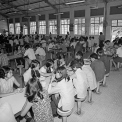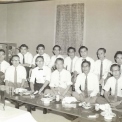Brief introduction of Hong Kong electronics industry
Electronic products can be divided into two categories: components and consumer goods. The former includes vacuum tubes, semiconductors (transistors, diodes, etc.), circuit boards and computer memory. The latter includes commodities such as radios, televisions, personal computers, phones, fax machines and calculators. Designing and testing the components in electronics industry require highly advanced production technologies, and are generally taken care of by professional engineers. The core components of consumer goods are circuit boards and semiconductors. Their manufacturing requires only installation with is less-advanced technology.
Electronics industry was an emerging industry in Hong Kong in the 1960s. The first electronics factory was established in 1959. Europe and Japan were the world’s pioneers in electronic technology. In the 1970s, the low production costs in Asia attracted manufactures of developed countries to come and set up factories and thus electronics technology was passed to Hong Kong. Electronics industry is a labor-intensive industry. Whether it is a factory manufacturing components or consumer goods, large numbers of female workers with sharp eyes and deft hands are needed. Hong Kong's electronics industry was chiefly founded on manufacturing of consumer goods, but the production of components also developed to a considerable scale.
Hong Kong electronics industry started by assembling transistor radios and its mainstream business was assembly of consumer goods which required lower technology. At the same time, the industry manufactured high-tech components such as computer memory and circuit boards. The electronics industry in Hong Kong started earlier than that of South Korea and Taiwan. In the early 1980s, Hong Kong had become one of Asia's high-tech centers and started to transfer skills to the surrounding areas. The situation was similar to foreign entrepreneurs investing in Hong Kong in the past. After some thirty years of rapid development, the electronics industry had become the second largest industry in Hong Kong in the 1990s. As most of the local electronics factories were founded only in the 1970s to the 1980s, electronics industry was still considered a young industry which required a relatively high level of technical competence compared to other industries.
Foreign investment on factories and technology transfer
The setting up of foreign-invested factories was a turning point for the development of electronics industry in Hong Kong. Major investors were large multinational corporations from the United States and Japan. In the 1960s, major electronics companies from these two countries exerted great efforts in developing the Asian market. At that time, low labour costs, coupled with the free trade policy adopted by the Hong Kong Government which allowed low taxation and free flow of foreign exchange attracted foreign investors to set up factories in Hong Kong. Investment patterns of the U.S. and Japan corporations were different. The former mainly set up branches in Hong Kong, focusing on the production of components such as semiconductors and computer memory; the latter usually established joint ventures with Hong Kong businessmen and produced electronic consumer goods.
The U.S. factories manufactured high-tech components and the factories were equipped with advanced designing, manufacturing and testing equipment, some even with large laboratories. Technical staff could absorb massive amounts of advanced scientific and technological knowhow. The U.S. factories kept an open attitude towards transferring technology. A Hong Kong branch had actually produced the memory system for the U.S army warplanes. The U.S. companies had high demand for quality so workers involving in manufacturing armament were required to attend training in the U.S. headquarters, and had to manufacture according to NASA specifications. The Chinese engineers often went to the U.S. for exchange, and sometimes they were sent to Europe and Japan to learn about the top technology in those companies. During that time, many Hong Kong branches of these U.S. factories were able to match their headquarters in terms of technical competence.
The U.S. companies were willing to promote local engineers, appoint them for high-rank positions such as department managers or even general managers. Certain Chinese managerial staffs were even employed to become directors of the Asia Pacific region. The Chinese management worked in U.S-funded companies for many years, and mastered the experiences of production, management and marketing which contributed to the successes of their future ventures. Fairchild, Ampex, Motorola and other U.S. enterprises could be described as the “Shaolin Temple” for the electronics industry in Hong Kong. They nurtured a large number of Hong Kong electronics factories owners who were blessed with a solid foundation and enormous potential.
The emergence of Hong Kong-funded electronics factories
In the 1960s and the 1970s, foreign investments took the lead in electronics industry. Hong Kong factories became more engaged in processes which required low technology such as the assembling of radios, televisions, electronic watches and other products. They were also involved in the production of some simple electronic components. Such factories were of small scale with limited capital. The factories and equipment were out-dated and only a small number of workers were employed.
The 1970s was the peak of start-up for electronics factories in Hong Kong. A small number of manufacturers had decided from the beginning to take a high-tech stream, and produced circuit boards, computer memory and other cutting-edge components. They launched brand-new products such as electronic toys, LCD monitors, personal computers and mobile phones. They led the trends of electronic goods. Hong Kong factories had modest capital so they focused on particular products in the initial stages. Many companies, after growing to a certain size, were capable of manufacturing both components and consumer goods.
The founders of most high-tech Hong Kong factories came from an electronics background, or had a master's degree or a Ph.D. in electronic engineering; or they had extensive experience serving as technical staff. Many of them had worked as engineers in U.S. factories, and had been long involved in testing, design and quality inspection processes. These manufacturers, having a technical background, had intimate knowledge of the operation of U.S. companies. It is hardly surprising after establishing their own companies, the owners usually adopted an American-style management and put in place holistic and healthy decision-making, personnel, finance and stockholding systems. Unlike local Chinese factories which had a family-based structure, these American-style Hong Kong electronics factories usually did not involve family members in their companies’ operation. In addition to generating a profit, many electronic industrial entrepreneurs had a passion in high technology right from the start and involved themselves in research and development endeavours. They were willing to take risks and invested in innovative businesses.
The evolution of electronic products
Electronic products can be categorized into consumer goods and components. With the rapid evolution of electronic technology and rapidly changing trends, new products are launched every two or three years. Most believed that Hong Kong's manufacturing industry is labor-intensive and low-tech. In fact, Hong Kong’s electronics industry was developed earlier than its South Korea and Taiwan counterparts. Technology has advanced and the products have diversified since the 1960s.
The first local electronic consumer product is a transistor radio and it was launched in 1959. Until the late 1970s, radio manufacturing still formed the backbone of electronics industry and its total export value was among the highest in electronic products. In the mid-1960s, local electronics factories began producing consumer goods with higher technical requirements like television sets and video recorders. In the 1970s, computers, electronic watches, game devices and electronic toys were launched one after another. The years 1977 to 1982 was the golden age of Hong Kong's electronic consumer goods manufacturing. Various kinds of new products were launched in just a few years which formed a huge consumer market. Many Hong Kong businessmen also took the opportunity to switch to the electronics industry.
Hong Kong's electronics industry was involved in more than low-tech assembling. In the late 1970s, with the opening of the U.S. telecommunications market, many Hong Kong manufacturers were involved in the manufacturing of mobile phones which required higher technology. Up until the mid-1980s, the large, blocky mobile cellular phones – known among the locals as “big brother phones” – had remained hugely popular. The mobile phones manufactured locally in the electronics factories could be exported to the U.S. In the early 1980s, audio-visual or communications equipment made in Hong Kong was also growing increasingly popular. Some prominent examples included cameras, tape recorders and fax machines. The products were of great variety, with famous local factories including Elec & Eltek and VTech. Since the late 1980s, personal computers have gradually become the mainstream in consumer products. Electronic factories producing computer peripherals such as monitors, hard drives, discs and modems emerged. Although Hong Kong also had computer manufacturers, unfortunately, latecomers South Korea and Taiwan surpassed Hong Kong in terms of technology and quality.
Production of components in Hong Kong started in the 1960s. At that time the U.S. enterprises had produced semiconductors, computer memory and other high-tech products. The most popular component was the transistor required for making radios. In the early 1970s, Hong Kong started producing circuit boards. The circuit board layers, technology and the utilization of circuit boards kept evolving. It promoted the research and development of various kinds of consumer goods. In 1979, Hong Kong started producing integrated circuits. It was the world’s most advanced technology which could greatly reduce the size of the products.
The transfer of production bases
Although the electronics industry was a high-tech industry and the investment in research and development far exceeds other industries, a large number of non-technical staff was still needed, for example female workers for the assembly lines. In addition, the electronics industry has strict requirements on factory specifications. An ideal factory should be big and single-storied. It is because high factories are prone to vibration which affects the accuracy of the machines. Unfortunately Hong Kong's high land prices makes finding enough space for building single-storied factories difficult.
In the late 1970s, China implemented the reform and open door policy. A special economic zone on the coast of Guangdong was set up and China enthusiastically encouraged foreign businessmen to set up factories there. Land was cheaper and wages were lower than in Hong Kong and thus many local electronics factories relocated their production to Shenzhen, Dongguan, Guangzhou and other cities in the Pearl River Delta. In the 1980s, labor and land costs in Hong Kong went up, and with neighboring countries actively developing electronics industry, Hong Kong's electronics industry faced a severe threat. Sadly, Hong Kong’s electronics manufacturers did not meet the challenge by upgrading their technological level, but instead relied on cheap labour and land from China as their sole business edge. However, in view of the 1997 issue and the June 4th incident, some large enterprises had reservations of investing in Mainland and set up factories in Southeast Asian countries instead. After the political atmosphere turned optimistic in the early 1990s, the enterprises started to set up factories in China.
Hong Kong factories in the Mainland were generally operated through joint-venture where Hong Kong businessmen formed ties with government-owned units. The Hong Kong side was responsible for technical, management and marketing while the Mainland unit was responsible for customs, handling of government documents etc. Hong Kong side owned a larger proportion of the shares. The northbound relocation of production raised the capacity and the production quantity of these Hong Kong factories and these enterprises could invest resources in improving quality, researching and developing new products and services. At the same time, rich experiences in production and management were transferred to the Mainland. The role of these enterprises was the same as the role played by the U.S. companies in Hong Kong in the early years. However, after moving to the north Hong Kong factories still export mainly overseas and most of them retained the OEM model. The low production cost in the Mainland had actually discouraged Hong Kong businessmen from transforming and upgrading. There were limited breakthroughs in production technology and in research and development.
Supplementary measures to the development of electronics industry
Hong Kong Government has pursued a policy of positive non-intervention for many years. The government mainly provides supplementary facilities to support the development of electronics industry. On the contrary, the governments in Taiwan, Singapore and Korea played a key role since the start-up stage of the electronics industry. In the 1960s, Hong Kong government established the Hong Kong Trade Development Council and the Productivity Council. The former helped the industry to expand the market while the latter provided professional support with an electronic service department designing products for local manufacturers. Governor MacLehose of the 1970s set up the Economic Diversity Council to promote local high-tech development and built the Tai Po Industrial Estate. His plan was to build the "Hong Kong Silicon Valley."
Tai Po Industrial Estate is a local high-tech center which attracts some large electronics factories to set up plants there. For example, in the early 1980s, three Hong Kong factories were founded in the industrial village and produced advanced components such as integrated circuits and others. However, the main function of the Industrial Estate remains in the rental of factories. The criteria for a land grant are too specific and sometimes fail to meet the requirements of electronic factories. In recent years, the electronics industry has become a major local industry, and the government has set up the Science and Technology Park, the Applied Science and Technology Research Institute, and the Innovation and Technology Commission in the new millennium to provide greater support to the electronics industry. Yet, industry veterans have reservations on what benefits these measures could bring to the industry.
Early Chinese engineers studied in the U.K. and U.S. Also there were many graduates from the University of Hong Kong, the Chinese University of Hong Kong and in the Electronics Department of the Hong Kong Polytechnic Institute. Vocational Training Council was established in 1982 and it serves to provide intermediate training to skilled workers in the electronics industry. Unlike European countries, Hong Kong’s electronics industry shared no close ties with the academia. University’s electronics courses mainly disseminate theory and knowledge and fail catch up with the technological development; Universities seldom invite practitioners to teach courses and veteran workers seldom hold seminars in the universities. In recent years, many large enterprises and colleges have begun to cooperate by setting up scientific research and training centres which gradually improve the communication between the two. This should help to facilitate the application of scientific research in the industry.
Reference
1.)Interview with Lee Peng Fei, 10 April 2010.
2.)Interview with H.Y Wong, 22 November 2010.
3.)Interview with David So, 10 and 17 March 2011.
4.)Indian Chamber of Commerce, Industrial Hong Kong: Electronics Industry, Hong Kong: Indian Chamber of Commerce, 1970.
5.)‘Electrical Goods and Accessories’, Hong Kong Trade Bulletin, Hong Kong: Dept. of Commerce and Industry (June 1960), p.181-182. 6.)‘Pocket Radios’, Hong Kong Trade Bulletin, Hong Kong: Dept. of Commerce and Industry (September 1960), p.271-272.
7.)‘Hong Kong Computer Industry Goes OEM’, Electronics Bulletin (Vol.2 No.4, 1982), Hong Kong: Information Services Division, Hong Kong Productivity Council, p.13.
8.)‘Hong Kong Ready to Challenge International Markets With High –Tech Semiconductors’, Electronics Bulletin (September, 1983), Hong Kong : Information Services Division, Hong Kong Productivity Council, p.25-27.
9.)‘Financing The Electronics Industry’, Electronics Bulletin (April 1984), Hong Kong: Information Services Division, Hong Kong Productivity Council, p.16-18.
10.)‘The Local Technicians’ Labour Market’, Electronics Bulletin (August 1984), Hong Kong: Information Services Division, Hong Kong Productivity Council, p.45-48.
11.)‘Moving Toward High-Tech Means Upgrading R&D And Engineering’, Electronics Bulletin (September 1985), Hong Kong: Information Services Division, Hong Kong Productivity Council, p.32.
12.)‘Educating Electronic Technologists and Technicians for the 1990’s’, Electronics Bulletin (January 1986), Hong Kong: Information Services Division, Hong Kong Productivity Council, p.56-57.
13.)‘The Local IC Industry Leaps Forward’, Electronics Bulletin (April 1986), Hong Kong: Information Services Division, Hong Kong Productivity Council, p.36-39.
14.)‘Hong Kong Launched into CD-Player Production ’, Electronics Bulletin (November 1986), Hong Kong: Information Services Division, Hong Kong Productivity Council, p.49.
15.)‘The Year of Electronic Toys’, Electronics Bulletin (January 1987), Hong Kong: Information Services Division, Hong Kong Productivity Council, p.32-35. 16.)‘Do We Have A High-Tech Future?’ Electronics Bulletin (May 1987), Hong Kong: Information Services Division, Hong Kong Productivity Council, p.42-43. 17.)‘Manpower Survey of HK Electronics Industry’, Electronics Bulletin (Vol.8 No.12, 1988), Hong Kong: Information Services Division, Hong Kong Productivity Council, p.60-61..
18.)‘Electronics: An Industry Transition’, Electronics Bulletin (Vol.9 No.1,1989), Hong Kong: Information Services Division, Hong Kong Productivity Council, p.59-61.
19.)Chen Kwan Yiu Edward, The electronics industry of Hong Kong: an analysis of its growth, Hong Kong: University of Hong Kong (Thesis M.Soc.Sc), 1971.
20.)Jeffrey Henderson, Hong Kong: high technology production and the making of a regional ‘core’, Hong Kong: Centre for Urban Studies and Urban Planning, University of Hong Kong, 1987.
21.)Au Wai-Kwong Elvis, Locational choice of Hong Kong's manufacturing industries: a case study of electronics industry, Hong Kong: University of Hong Kong (Thesis M..Sc), 1988.
22.)Yip Chi Wai Rudolph., A study of American and Japanese electronics manufacturing investments in Hong Kong, Hong Kong: University of Hong Kong, (Thesis MBA), 1988.
23.)Li, Sai-keung., Export marketing of Hong Kong electronic products: a relationship approach, Hong Kong: University of Hong Kong (Thesis MBA), 1993.
24.)Ho Siu-Cheung Alfred, The pattern of success in Hong Kong electronics industry, Hong Kong: University of Hong Kong (Thesis MBA), 1996.





